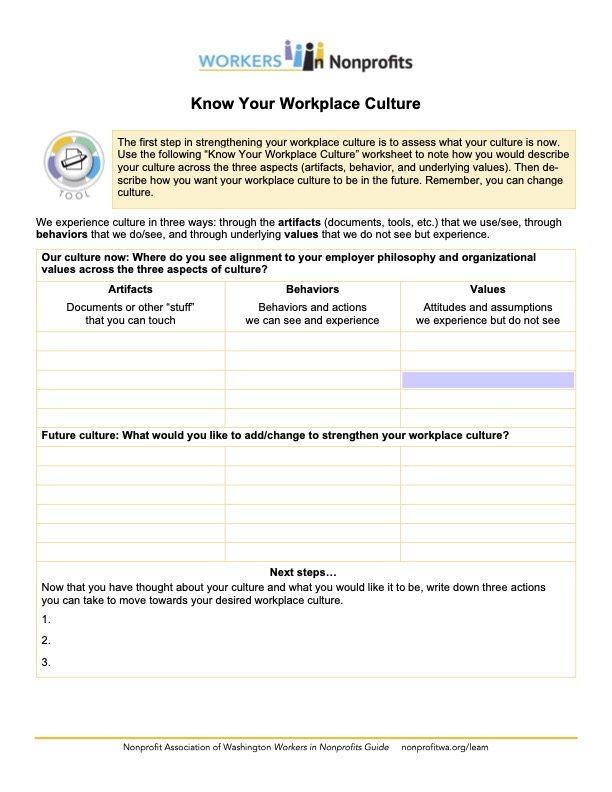Aspects of culture are both visible and invisible, and culture is often compared to an iceberg because 90% of an iceberg is unseen below the waterline. We aspire to create a workplace culture that supports our mission and values. We explore the visible and invisible parts of our culture to better understand where we are now and what changes we want to make. A strong workplace culture is vital to every nonprofit organization.
In a workplace, culture includes the systems of knowledge shared by workers – the values, beliefs, attitudes, and roles individuals take within the organization. Culture in general shows up in three ways: artifacts, behavior, and underlying values. We break this down with the following examples related to workers and the workplace.
Artifacts
Artifacts are the “stuff” of the organization. This includes things that someone could see by walking around your workplace. Some artifacts are less visible and may be known by specific workers. Artifacts can be tools, documents, procedures, and more. Together, your artifacts represent visible or accessible indicators of your nonprofit’s policies and protocols for workers.
Use the list below to think about what the artifacts are for your organization.
- Incorporation documents
- Business license
- Strategic plan
- Employment handbook*
- Employee benefits
- Onboarding plans
- Workplace safety and health plans
- Budgets
- Payroll systems
- Training guides and plans
- Non-discrimination policies
- Performance evaluation policies
- Worker bulletin board(s)
- Organizational chart
- Tools and technology used
*NAWA Members – You have access to NAWA’s Employee Handbook as a sample resource. Find the handbook on the Member Resources page.
Behavior
What we can observe or witness when team members interact within the workplace are behaviors. Behaviors include:
- Conversations – what people talk about
- Causal workplace comments
- Participation in meetings
- How people interact across the organizational structure, like workers and board or workers and people served
- How individuals and teams respond when faced by a challenge or conflict
- How you track worker performance
Underlying Values
Underlying values are invisible elements that nevertheless shape a culture. A nonprofit can say that their workers are important, valued, and integral to mission achievement, and underlying convictions must exist so that everyone in the organization matches their words with appropriate actions. The invisible elements may include:
- Values related to what matters within an organization
- Assumptions that common understandings are shared
Attitudes about data and record-keeping - Attitudes about what is acceptable behavior
- Attitudes about the people you serve
- Unspoken rules
- Unspoken perceptions about the workplace environment
- Beliefs
- Habits
Assess Your Culture

One way to understand the underlying values of your workplace culture is to interview individuals from different layers of the nonprofit: board, leadership team members, workers, and people served.

The first step in strengthening your workplace culture is to assess what your culture is now. Use the following “Know Your Workplace Culture” worksheet to note how you would describe your culture across the three aspects (artifacts, behavior, and underlying values). Then describe how you want your workplace culture to be in the future. Remember, you can change culture.
